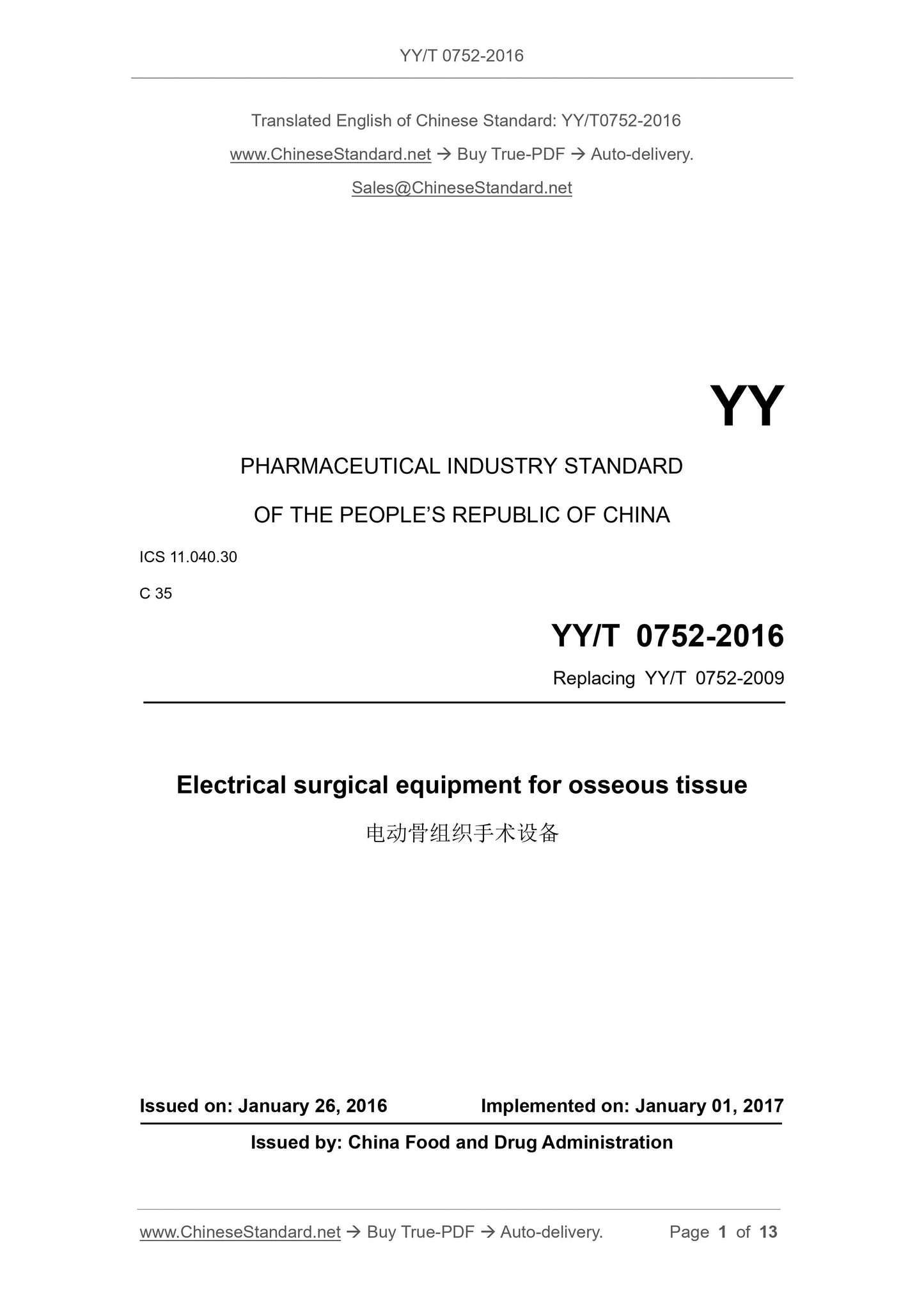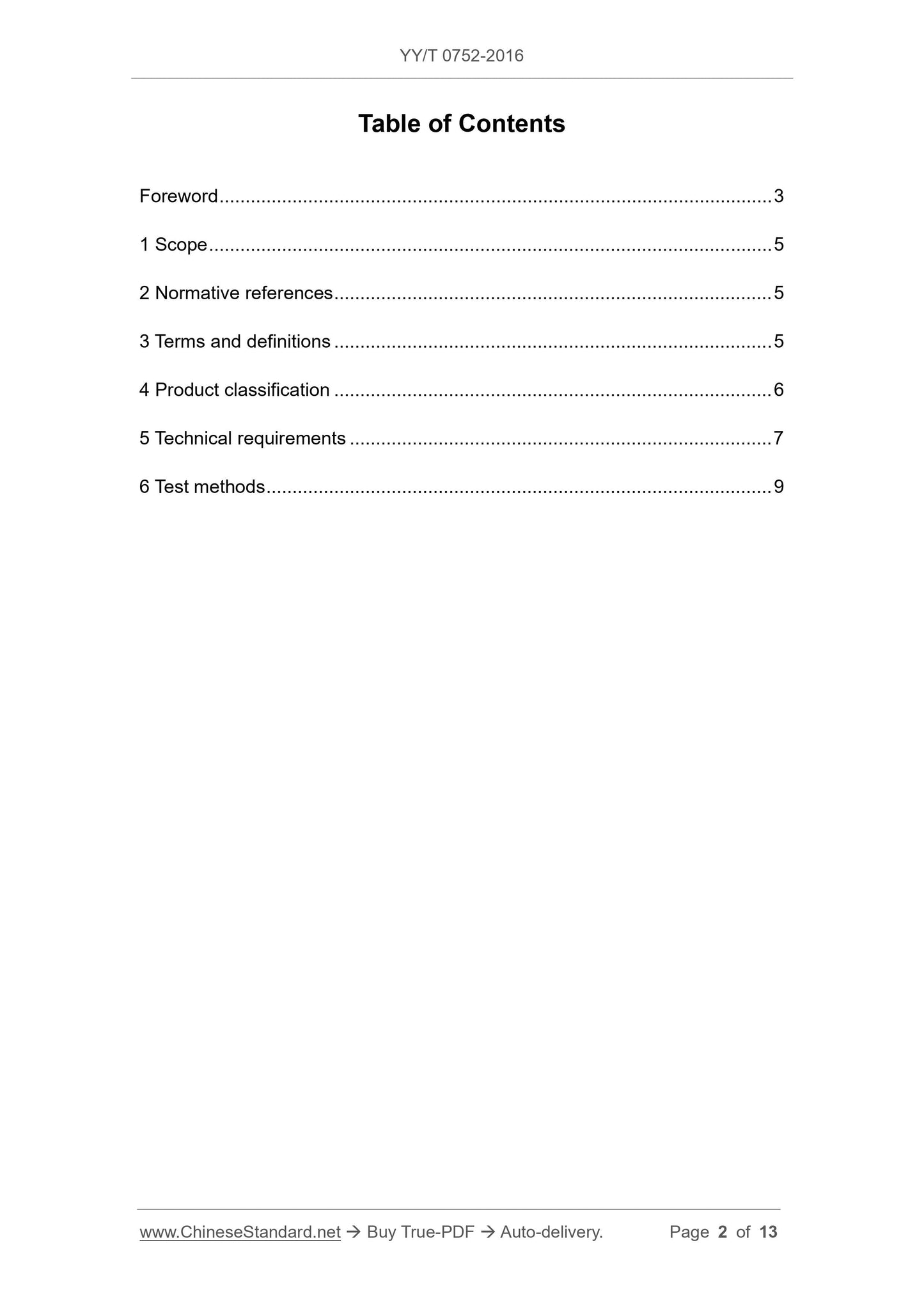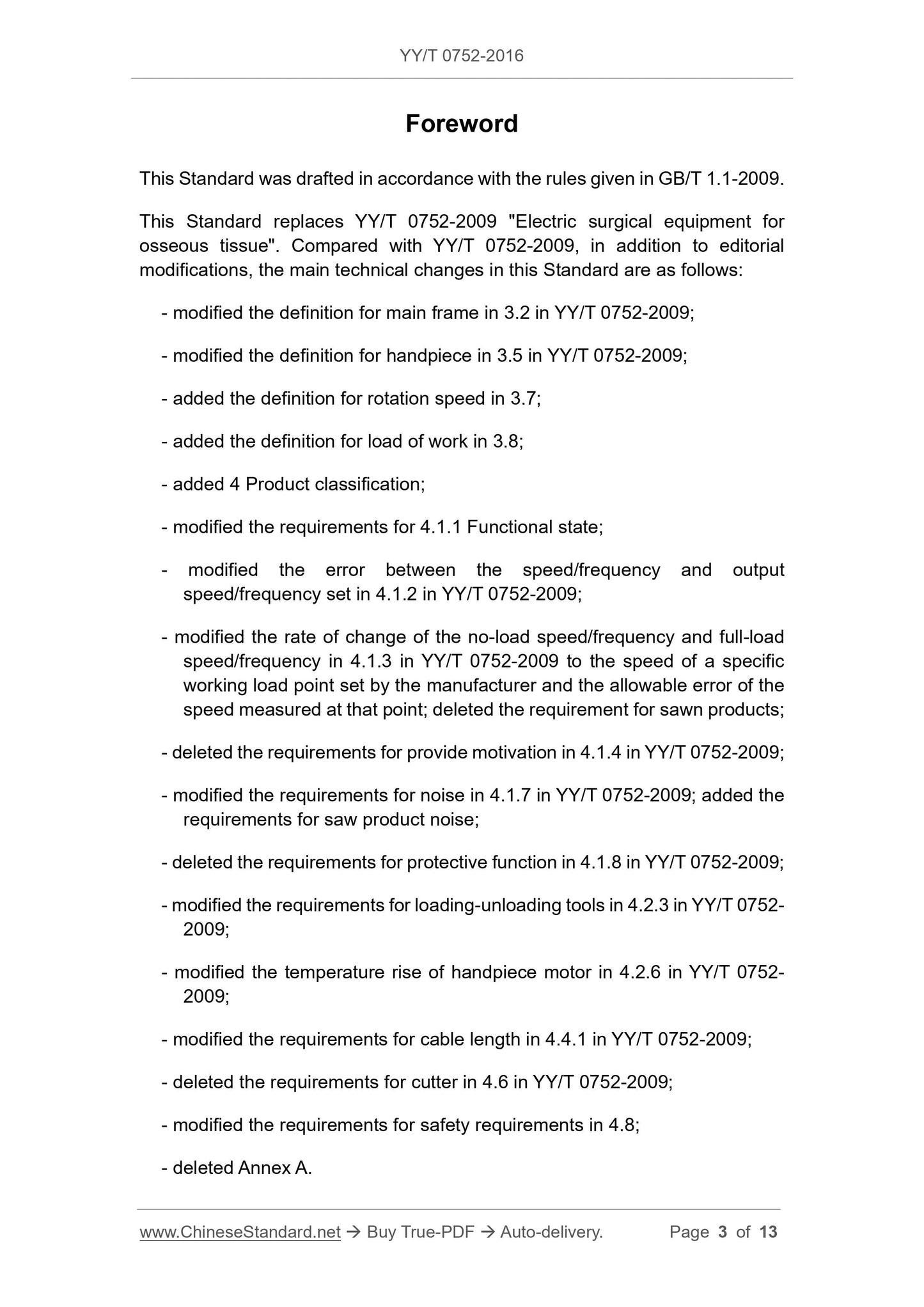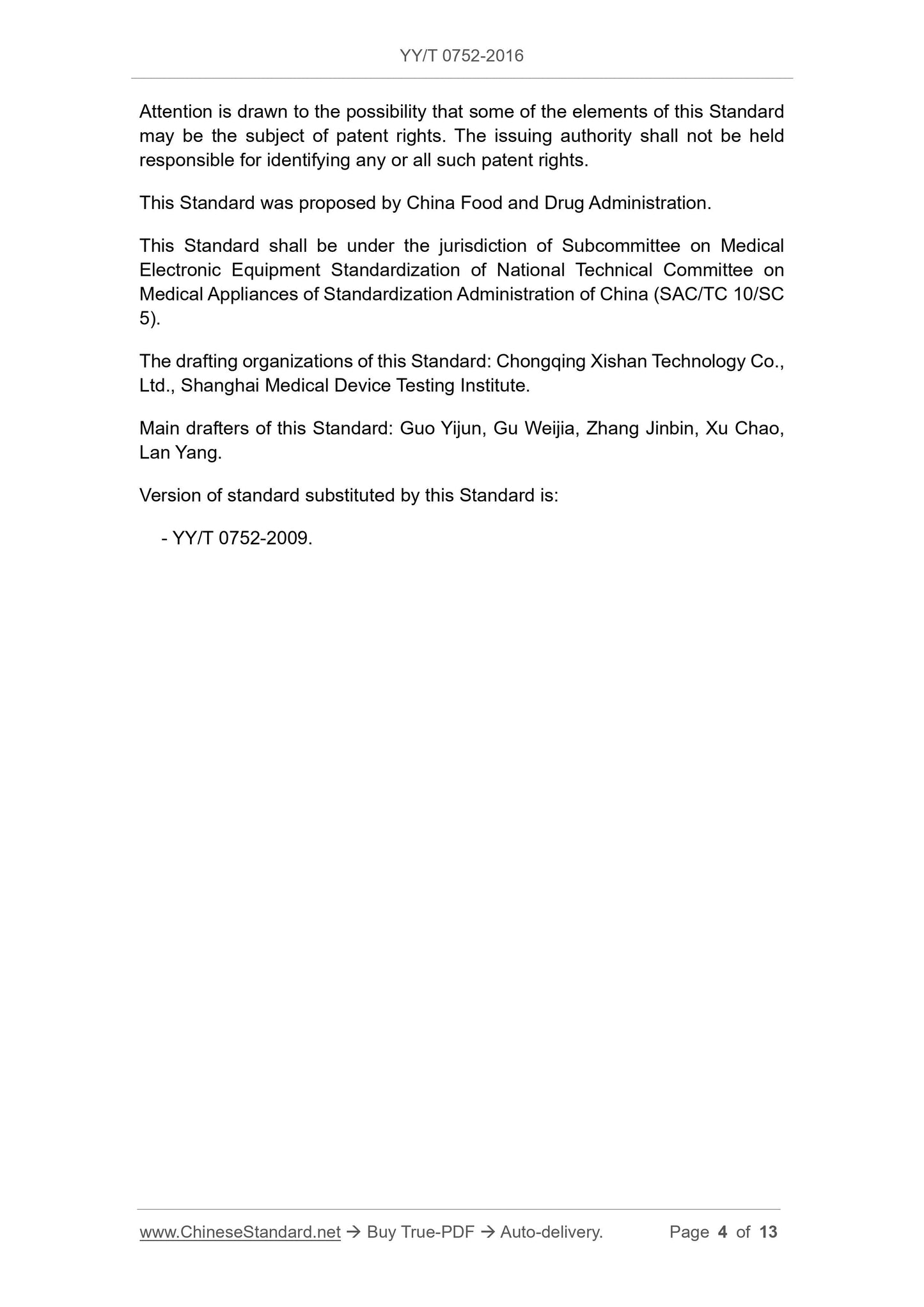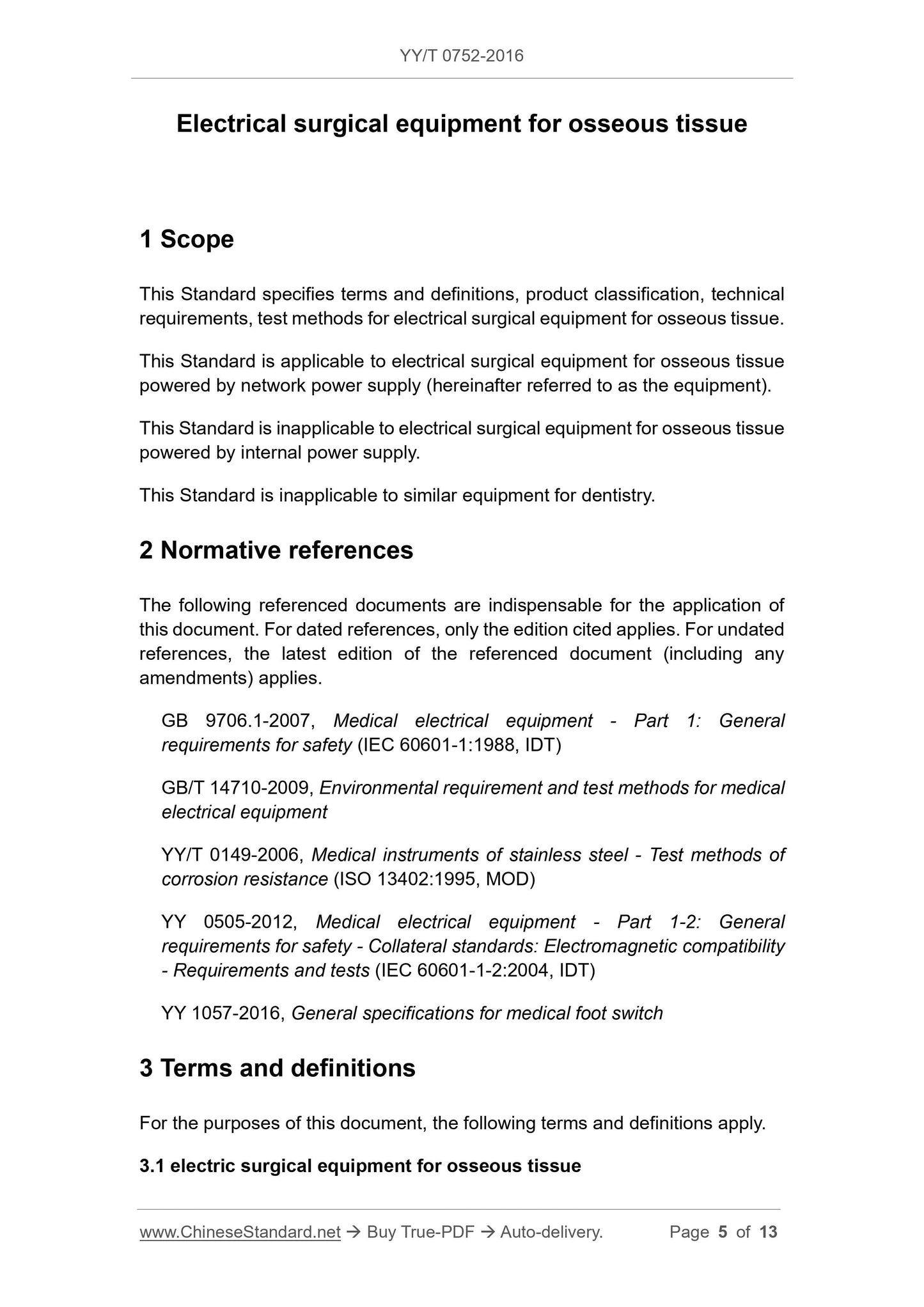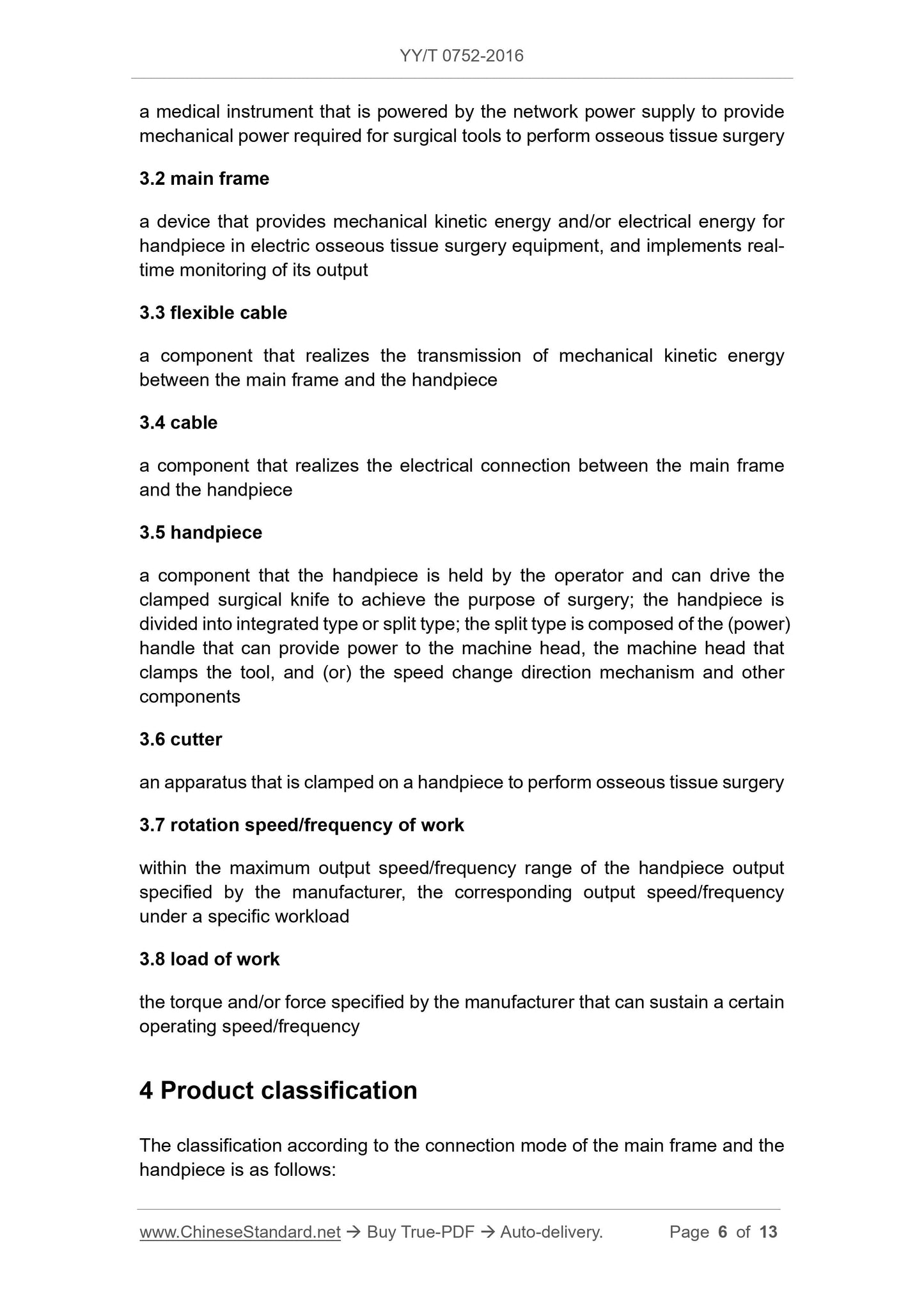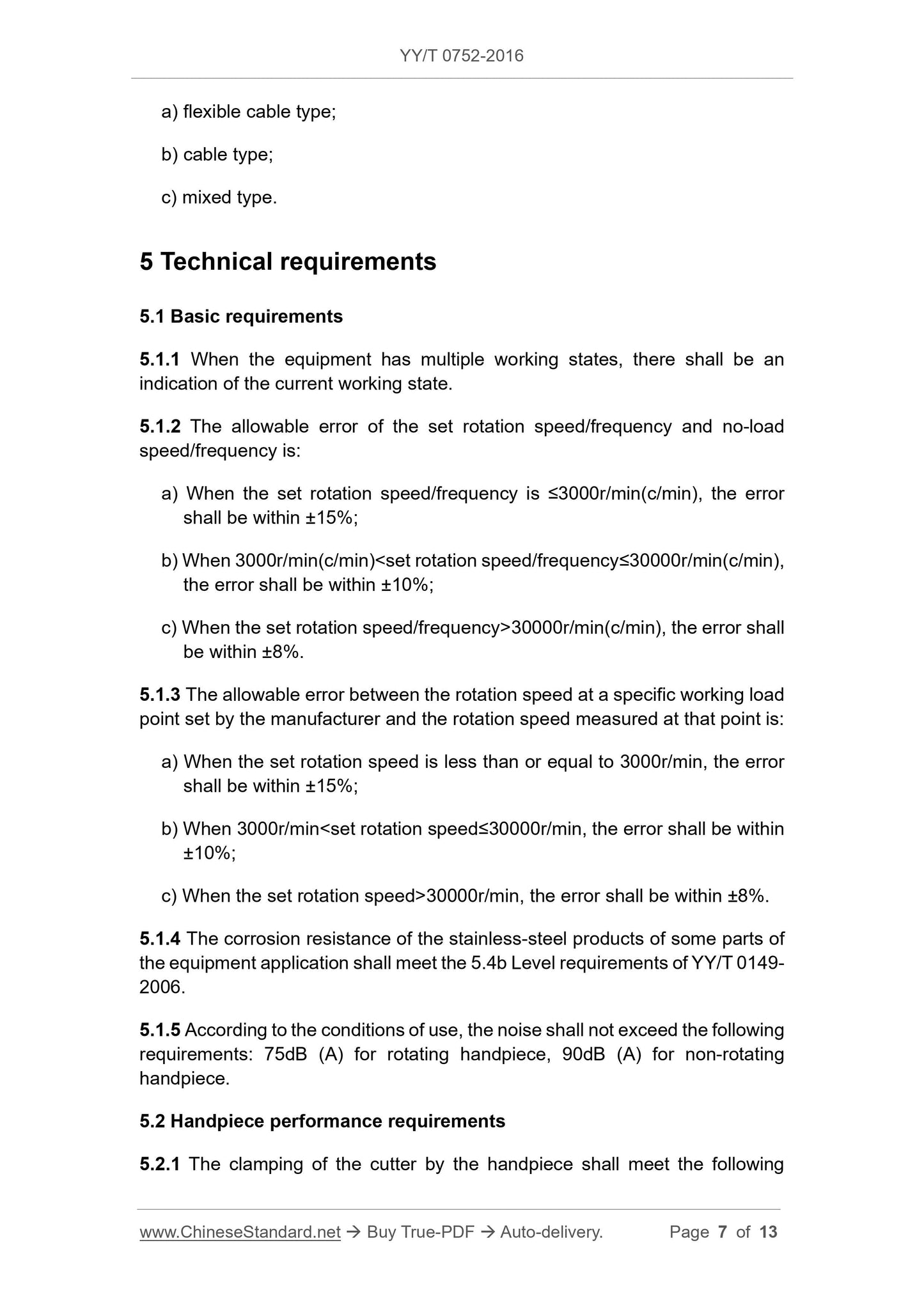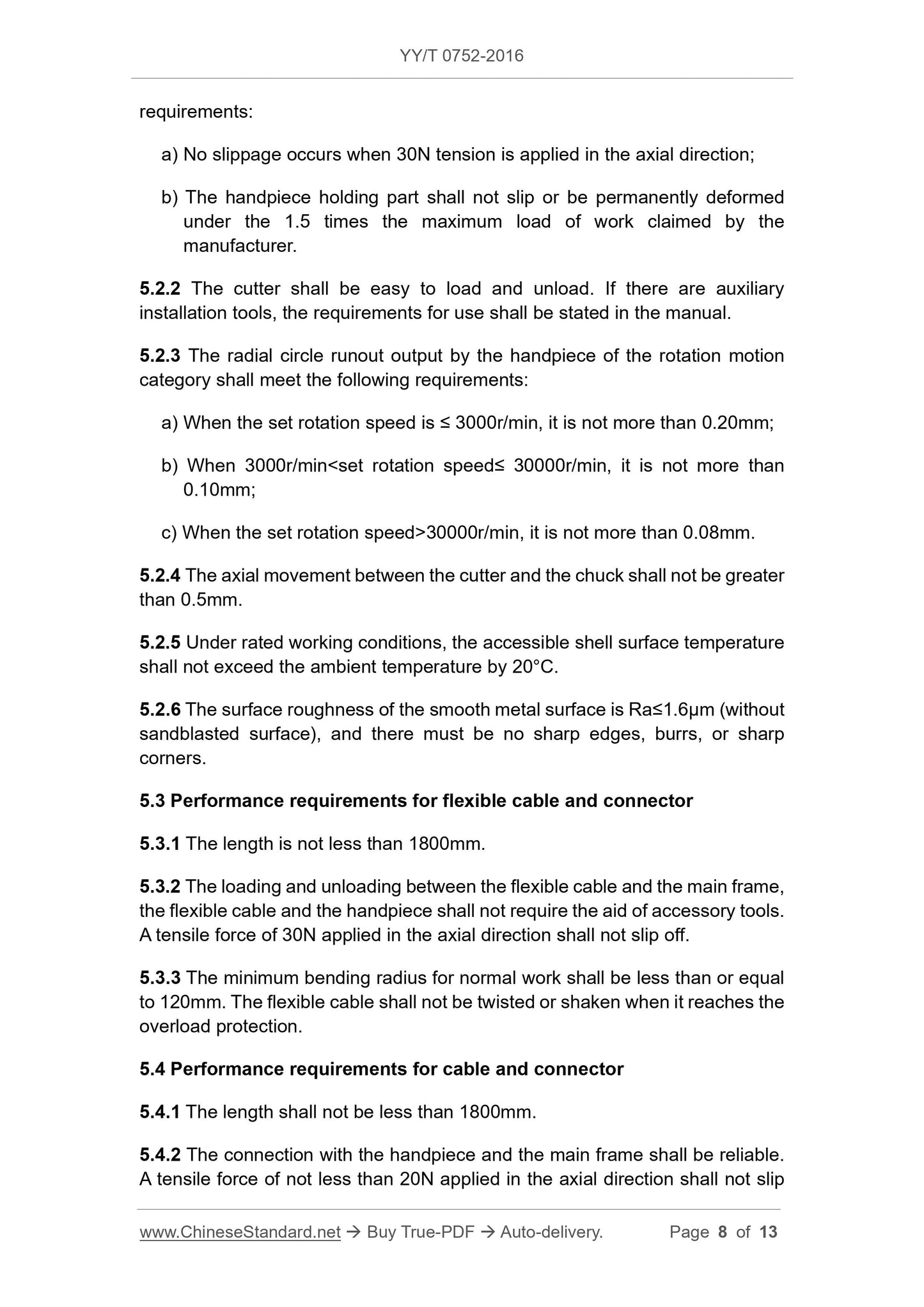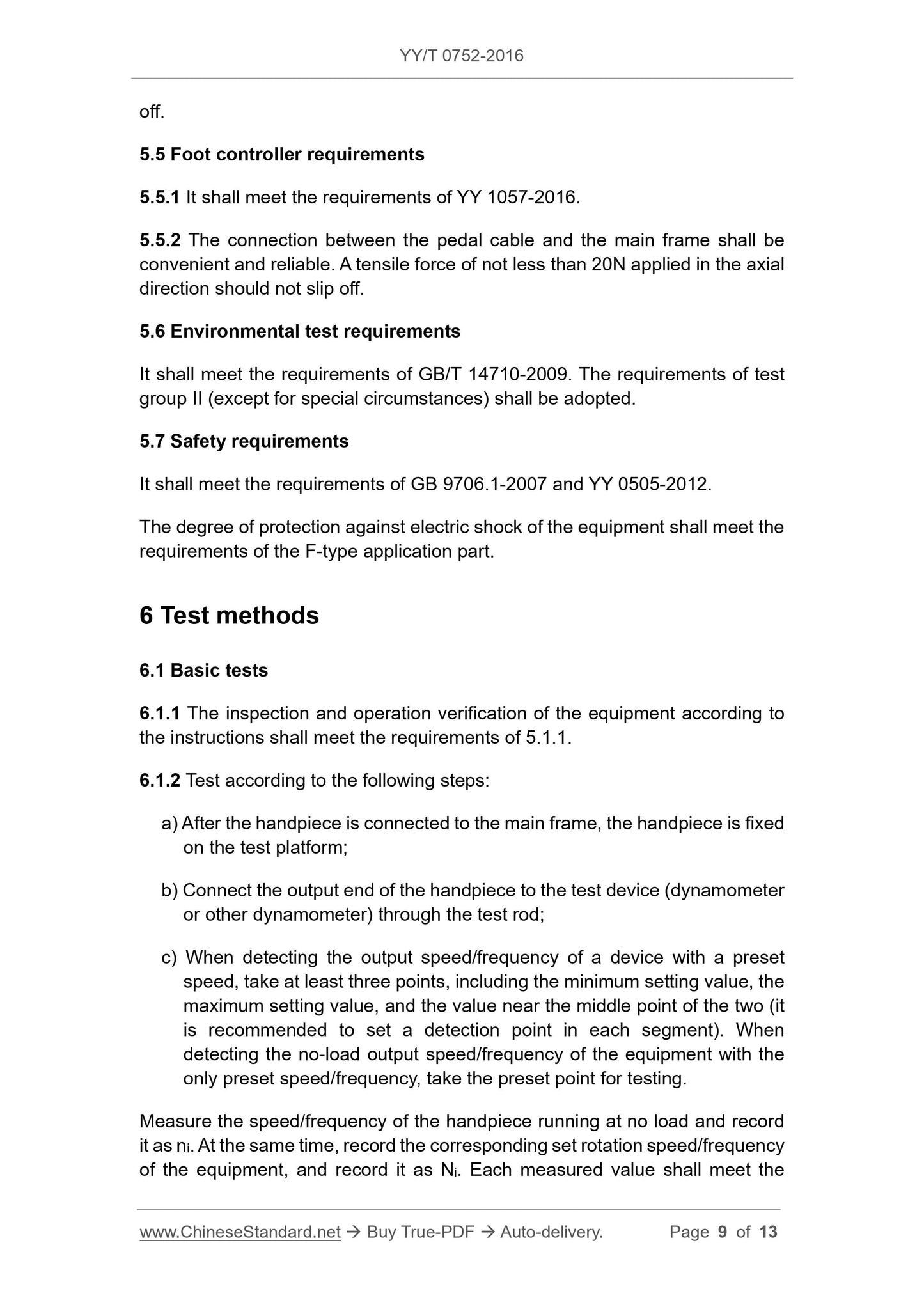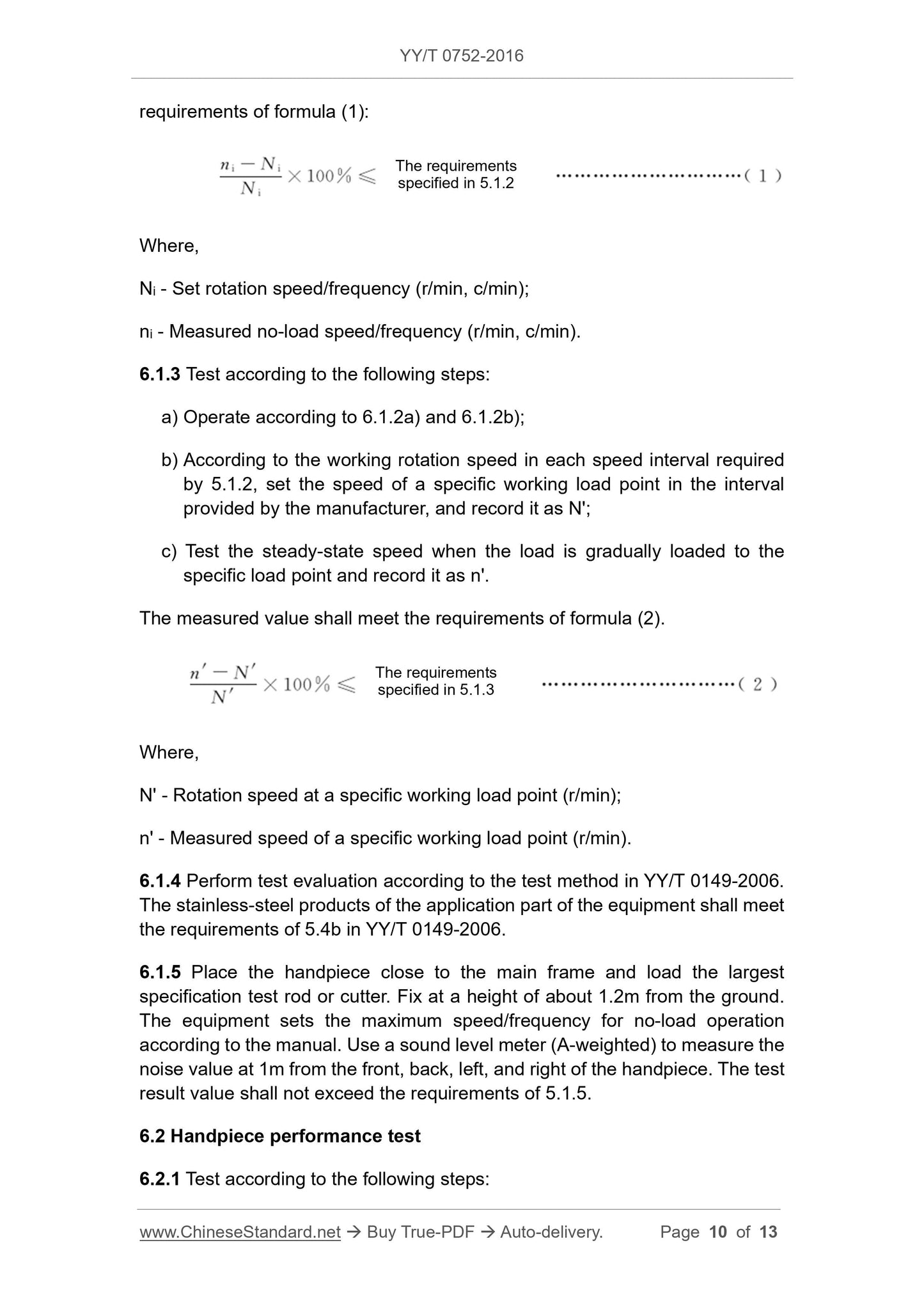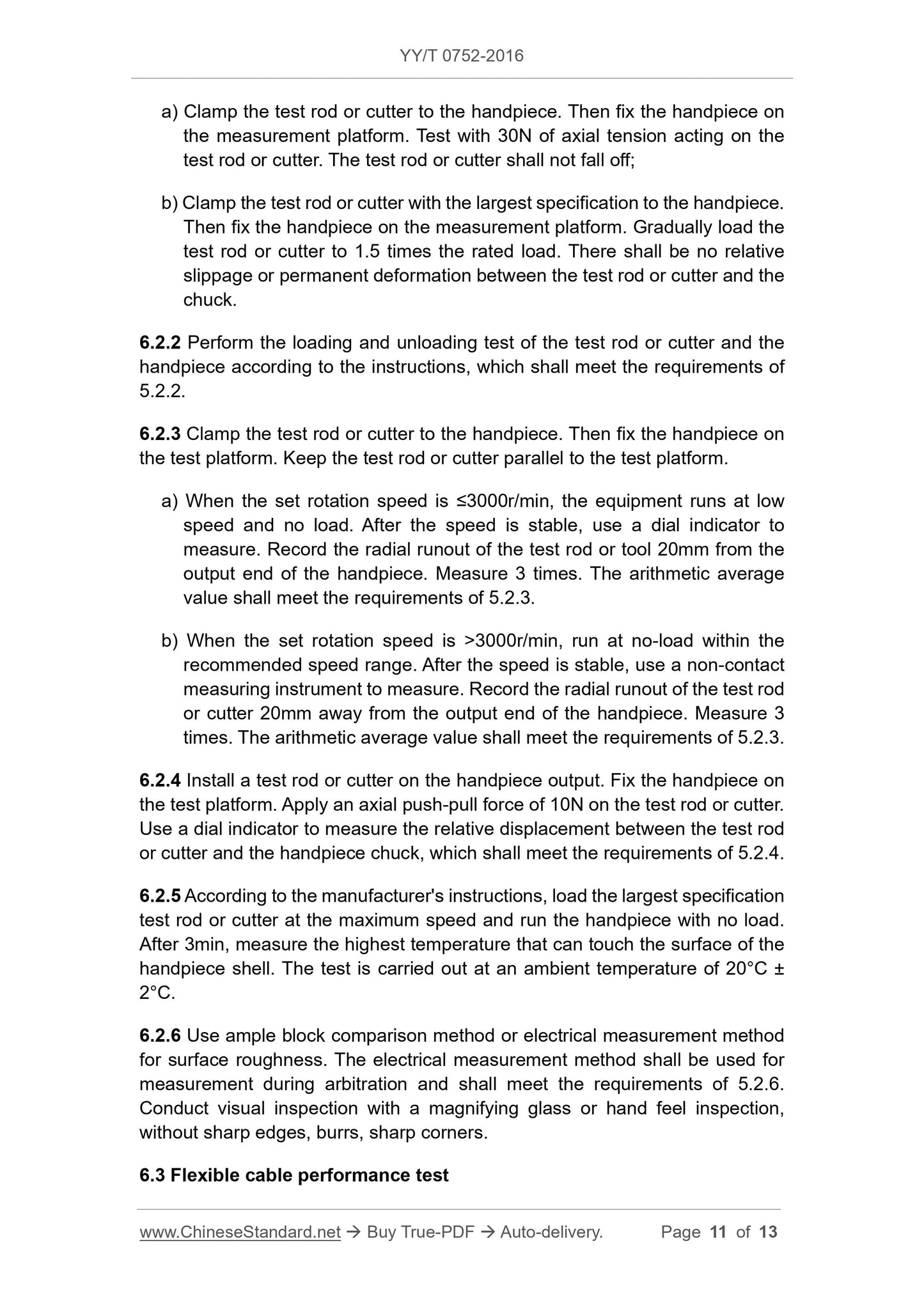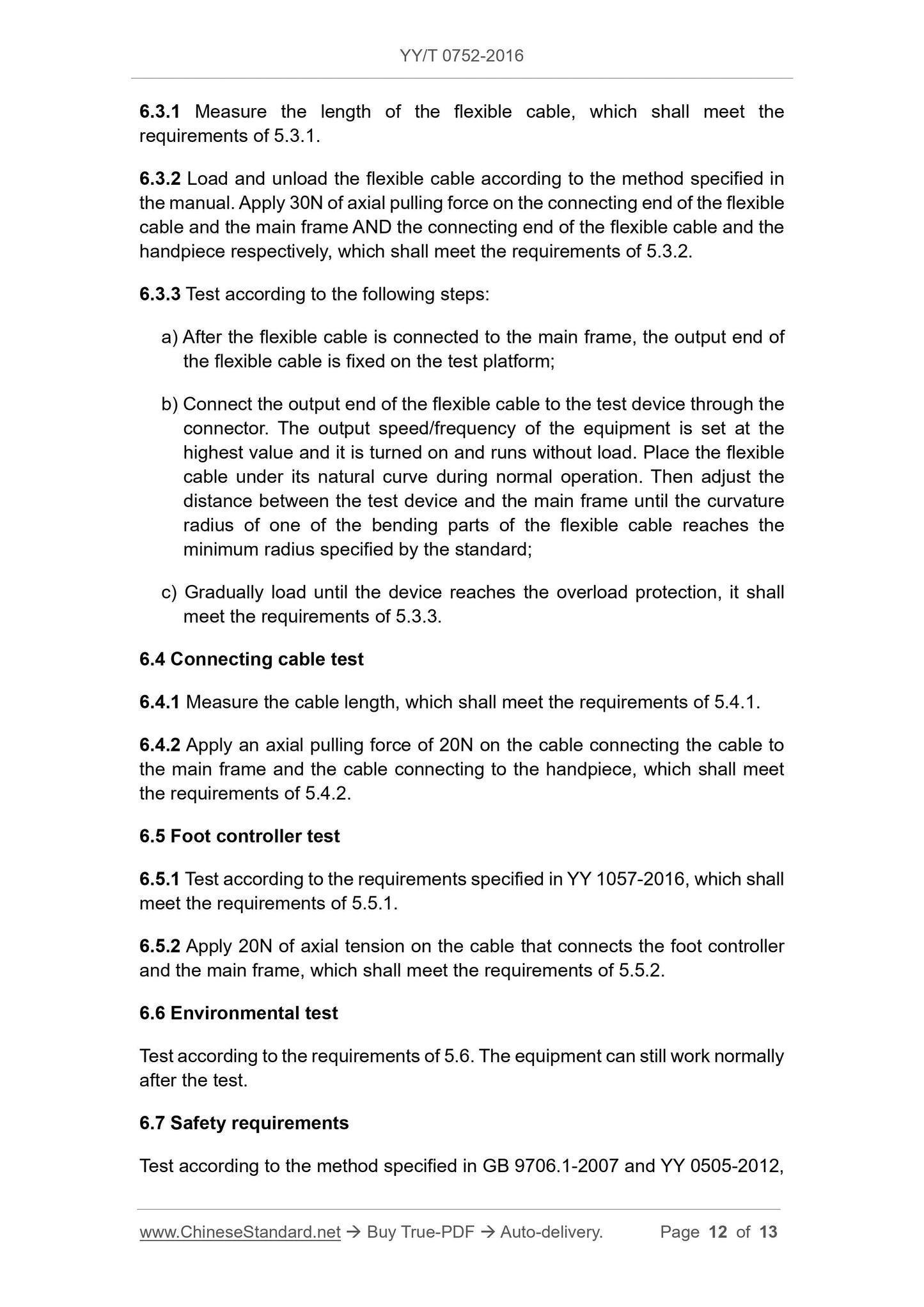PayPal, credit cards. Download editable-PDF & invoice in 1 second!
YY/T 0752-2016 English PDF (YYT0752-2016)
YY/T 0752-2016 English PDF (YYT0752-2016)
Precio habitual
$140.00 USD
Precio habitual
Precio de oferta
$140.00 USD
Precio unitario
/
por
Los gastos de envío se calculan en la pantalla de pago.
No se pudo cargar la disponibilidad de retiro
Delivery: 3 seconds. Download true-PDF + Invoice.
Get QUOTATION in 1-minute: Click YY/T 0752-2016
Historical versions: YY/T 0752-2016
Preview True-PDF (Reload/Scroll if blank)
YY/T 0752-2016: Electrical surgical equipment for osseous tissue
YY/T 0752-2016
YY
PHARMACEUTICAL INDUSTRY STANDARD
OF THE PEOPLE’S REPUBLIC OF CHINA
ICS 11.040.30
C 35
Replacing YY/T 0752-2009
Electrical surgical equipment for osseous tissue
ISSUED ON: JANUARY 26, 2016
IMPLEMENTED ON: JANUARY 01, 2017
Issued by: China Food and Drug Administration
Table of Contents
Foreword ... 3
1 Scope ... 5
2 Normative references ... 5
3 Terms and definitions ... 5
4 Product classification ... 6
5 Technical requirements ... 7
6 Test methods ... 9
Electrical surgical equipment for osseous tissue
1 Scope
This Standard specifies terms and definitions, product classification, technical
requirements, test methods for electrical surgical equipment for osseous tissue.
This Standard is applicable to electrical surgical equipment for osseous tissue
powered by network power supply (hereinafter referred to as the equipment).
This Standard is inapplicable to electrical surgical equipment for osseous tissue
powered by internal power supply.
This Standard is inapplicable to similar equipment for dentistry.
2 Normative references
The following referenced documents are indispensable for the application of
this document. For dated references, only the edition cited applies. For undated
references, the latest edition of the referenced document (including any
amendments) applies.
GB 9706.1-2007, Medical electrical equipment - Part 1: General
requirements for safety (IEC 60601-1:1988, IDT)
GB/T 14710-2009, Environmental requirement and test methods for medical
electrical equipment
YY/T 0149-2006, Medical instruments of stainless steel - Test methods of
corrosion resistance (ISO 13402:1995, MOD)
YY 0505-2012, Medical electrical equipment - Part 1-2: General
requirements for safety - Collateral standards: Electromagnetic compatibility
- Requirements and tests (IEC 60601-1-2:2004, IDT)
YY 1057-2016, General specifications for medical foot switch
3 Terms and definitions
For the purposes of this document, the following terms and definitions apply.
3.1 electric surgical equipment for osseous tissue
a medical instrument that is powered by the network power supply to provide
mechanical power required for surgical tools to perform osseous tissue surgery
3.2 main frame
a device that provides mechanical kinetic energy and/or electrical energy for
handpiece in electric osseous tissue surgery equipment, and implements real-
time monitoring of its output
3.3 flexible cable
a component that realizes the transmission of mechanical kinetic energy
between the main frame and the handpiece
3.4 cable
a component that realizes the electrical connection between the main frame
and the handpiece
3.5 handpiece
a component that the handpiece is held by the operator and can drive the
clamped surgical knife to achieve the purpose of surgery; the handpiece is
divided into integrated type or split type; the split type is composed of the (power)
handle that can provide power to the machine head, the machine head that
clamps the tool, and (or) the speed change direction mechanism and other
components
3.6 cutter
an apparatus that is clamped on a handpiece to perform osseous tissue surgery
3.7 rotation speed/frequency of work
within the maximum output speed/frequency range of the handpiece output
specified by the manufacturer, the corresponding output speed/frequency
under a specific workload
3.8 load of work
the torque and/or force specified by the manufacturer that can sustain a certain
operating speed/frequency
4 Product classification
The classification according to the connection mode of the main frame and the
handpiece is as follows:
a) Clamp the test rod or cutter to the handpiece. Then fix the handpiece on
the measurement platform. Test with 30N of axial tension acting on the
test rod or cutter. The test rod or cutter shall not fall off;
b) Clamp the test rod or cutter with the largest specification to the handpiece.
Then fix the handpiece on the measurement platform. Gradually load the
test rod or cutter to 1.5 times the rated load. There shall be no relative
slippage or permanent deformation between the test rod or cutter and the
chuck.
6.2.2 Perform the loading and unloading test of the test rod or cutter and the
handpiece according to the instructions, which shall meet the requirements of
5.2.2.
6.2.3 Clamp the test rod or cutter to the handpiece. Then fix the handpiece on
the test platform. Keep the test rod or cutter parallel to the test platform.
a) When the set rotation speed is ≤3000r/min, the equipment runs at low
speed and no load. After the speed is stable, use a dial indicator to
measure. Record the radial runout of the test rod or tool 20mm from the
output end of the handpiece. Measure 3 times. The arithmetic average
value shall meet the requirements of 5.2.3.
b) When the set rotation speed is >3000r/min, run at no-load within the
recommended speed range. After the speed is stable, use a non-contact
measuring instrument to measure. Record the radial runout of the test rod
or cutter 20mm away from the output end of the handpiece. Measure 3
times. The arithmetic average value shall meet the requirements of 5.2.3.
6.2.4 Install a test rod or cutter on the handpiece output. Fix the handpiece on
the test platform. Apply an axial push-pull force of 10N on the test rod or cutter.
Use a dial indicator to measure the relative displacement between the test rod
or cutter and the handpiece chuck, which shall meet the requirements of 5.2.4.
6.2.5 According to the manufacturer's instructions, load the largest specification
test rod or cutter at the maximum speed and run the handpiece with no load.
After 3min, measure the highest temperature that can touch the surface of the
handpiece shell. The test is carried out at an ambient temperature of 20°C ±
2°C.
6.2.6 Use ample block comparison method or electrical measurement method
for surface roughness. The electrical measurement method shall be used for
measurement during arbitration and shall meet the requirements of 5.2.6.
Conduct visual inspection with a magnifying glass or hand feel inspection,
without sharp edges, burrs, sharp corners.
6.3 Flexible cable performance test
6.3.1 Measure the length of the flexible cable, which shall meet the
requirements of 5.3.1.
6.3.2 Load and unload the flexible cable according to the method specified in
the manual. Apply 30N of axial pulling force on the connecting end of the flexible
cable and the main frame AND the connecting end of the flexible cable and the
handpiece respectively, which shall meet the requirements of 5.3.2.
6.3.3 Test according to the following steps:
a) After the flexible cable is connected to the main frame, the output end of
the flexible cable is fixed on the test platform;
b) Connect the output end of the flexible cable to the test device through the
connector. The output speed/frequency of the equipment is set at the
highest value and it is turned on and runs without load. Place the flexible
cable under its natural curve during normal operation. Then adjust the
distance between the test device and the main frame until the curvature
radius of one of the bending parts of the flexible cable reaches the
minimum radius specified by the standard;
c) Gradually load until the device reaches the overload protection, it shall
meet the requirements of 5.3.3.
6.4 Connecting cable test
6.4.1 Measure the cable ...
Get QUOTATION in 1-minute: Click YY/T 0752-2016
Historical versions: YY/T 0752-2016
Preview True-PDF (Reload/Scroll if blank)
YY/T 0752-2016: Electrical surgical equipment for osseous tissue
YY/T 0752-2016
YY
PHARMACEUTICAL INDUSTRY STANDARD
OF THE PEOPLE’S REPUBLIC OF CHINA
ICS 11.040.30
C 35
Replacing YY/T 0752-2009
Electrical surgical equipment for osseous tissue
ISSUED ON: JANUARY 26, 2016
IMPLEMENTED ON: JANUARY 01, 2017
Issued by: China Food and Drug Administration
Table of Contents
Foreword ... 3
1 Scope ... 5
2 Normative references ... 5
3 Terms and definitions ... 5
4 Product classification ... 6
5 Technical requirements ... 7
6 Test methods ... 9
Electrical surgical equipment for osseous tissue
1 Scope
This Standard specifies terms and definitions, product classification, technical
requirements, test methods for electrical surgical equipment for osseous tissue.
This Standard is applicable to electrical surgical equipment for osseous tissue
powered by network power supply (hereinafter referred to as the equipment).
This Standard is inapplicable to electrical surgical equipment for osseous tissue
powered by internal power supply.
This Standard is inapplicable to similar equipment for dentistry.
2 Normative references
The following referenced documents are indispensable for the application of
this document. For dated references, only the edition cited applies. For undated
references, the latest edition of the referenced document (including any
amendments) applies.
GB 9706.1-2007, Medical electrical equipment - Part 1: General
requirements for safety (IEC 60601-1:1988, IDT)
GB/T 14710-2009, Environmental requirement and test methods for medical
electrical equipment
YY/T 0149-2006, Medical instruments of stainless steel - Test methods of
corrosion resistance (ISO 13402:1995, MOD)
YY 0505-2012, Medical electrical equipment - Part 1-2: General
requirements for safety - Collateral standards: Electromagnetic compatibility
- Requirements and tests (IEC 60601-1-2:2004, IDT)
YY 1057-2016, General specifications for medical foot switch
3 Terms and definitions
For the purposes of this document, the following terms and definitions apply.
3.1 electric surgical equipment for osseous tissue
a medical instrument that is powered by the network power supply to provide
mechanical power required for surgical tools to perform osseous tissue surgery
3.2 main frame
a device that provides mechanical kinetic energy and/or electrical energy for
handpiece in electric osseous tissue surgery equipment, and implements real-
time monitoring of its output
3.3 flexible cable
a component that realizes the transmission of mechanical kinetic energy
between the main frame and the handpiece
3.4 cable
a component that realizes the electrical connection between the main frame
and the handpiece
3.5 handpiece
a component that the handpiece is held by the operator and can drive the
clamped surgical knife to achieve the purpose of surgery; the handpiece is
divided into integrated type or split type; the split type is composed of the (power)
handle that can provide power to the machine head, the machine head that
clamps the tool, and (or) the speed change direction mechanism and other
components
3.6 cutter
an apparatus that is clamped on a handpiece to perform osseous tissue surgery
3.7 rotation speed/frequency of work
within the maximum output speed/frequency range of the handpiece output
specified by the manufacturer, the corresponding output speed/frequency
under a specific workload
3.8 load of work
the torque and/or force specified by the manufacturer that can sustain a certain
operating speed/frequency
4 Product classification
The classification according to the connection mode of the main frame and the
handpiece is as follows:
a) Clamp the test rod or cutter to the handpiece. Then fix the handpiece on
the measurement platform. Test with 30N of axial tension acting on the
test rod or cutter. The test rod or cutter shall not fall off;
b) Clamp the test rod or cutter with the largest specification to the handpiece.
Then fix the handpiece on the measurement platform. Gradually load the
test rod or cutter to 1.5 times the rated load. There shall be no relative
slippage or permanent deformation between the test rod or cutter and the
chuck.
6.2.2 Perform the loading and unloading test of the test rod or cutter and the
handpiece according to the instructions, which shall meet the requirements of
5.2.2.
6.2.3 Clamp the test rod or cutter to the handpiece. Then fix the handpiece on
the test platform. Keep the test rod or cutter parallel to the test platform.
a) When the set rotation speed is ≤3000r/min, the equipment runs at low
speed and no load. After the speed is stable, use a dial indicator to
measure. Record the radial runout of the test rod or tool 20mm from the
output end of the handpiece. Measure 3 times. The arithmetic average
value shall meet the requirements of 5.2.3.
b) When the set rotation speed is >3000r/min, run at no-load within the
recommended speed range. After the speed is stable, use a non-contact
measuring instrument to measure. Record the radial runout of the test rod
or cutter 20mm away from the output end of the handpiece. Measure 3
times. The arithmetic average value shall meet the requirements of 5.2.3.
6.2.4 Install a test rod or cutter on the handpiece output. Fix the handpiece on
the test platform. Apply an axial push-pull force of 10N on the test rod or cutter.
Use a dial indicator to measure the relative displacement between the test rod
or cutter and the handpiece chuck, which shall meet the requirements of 5.2.4.
6.2.5 According to the manufacturer's instructions, load the largest specification
test rod or cutter at the maximum speed and run the handpiece with no load.
After 3min, measure the highest temperature that can touch the surface of the
handpiece shell. The test is carried out at an ambient temperature of 20°C ±
2°C.
6.2.6 Use ample block comparison method or electrical measurement method
for surface roughness. The electrical measurement method shall be used for
measurement during arbitration and shall meet the requirements of 5.2.6.
Conduct visual inspection with a magnifying glass or hand feel inspection,
without sharp edges, burrs, sharp corners.
6.3 Flexible cable performance test
6.3.1 Measure the length of the flexible cable, which shall meet the
requirements of 5.3.1.
6.3.2 Load and unload the flexible cable according to the method specified in
the manual. Apply 30N of axial pulling force on the connecting end of the flexible
cable and the main frame AND the connecting end of the flexible cable and the
handpiece respectively, which shall meet the requirements of 5.3.2.
6.3.3 Test according to the following steps:
a) After the flexible cable is connected to the main frame, the output end of
the flexible cable is fixed on the test platform;
b) Connect the output end of the flexible cable to the test device through the
connector. The output speed/frequency of the equipment is set at the
highest value and it is turned on and runs without load. Place the flexible
cable under its natural curve during normal operation. Then adjust the
distance between the test device and the main frame until the curvature
radius of one of the bending parts of the flexible cable reaches the
minimum radius specified by the standard;
c) Gradually load until the device reaches the overload protection, it shall
meet the requirements of 5.3.3.
6.4 Connecting cable test
6.4.1 Measure the cable ...
Share
